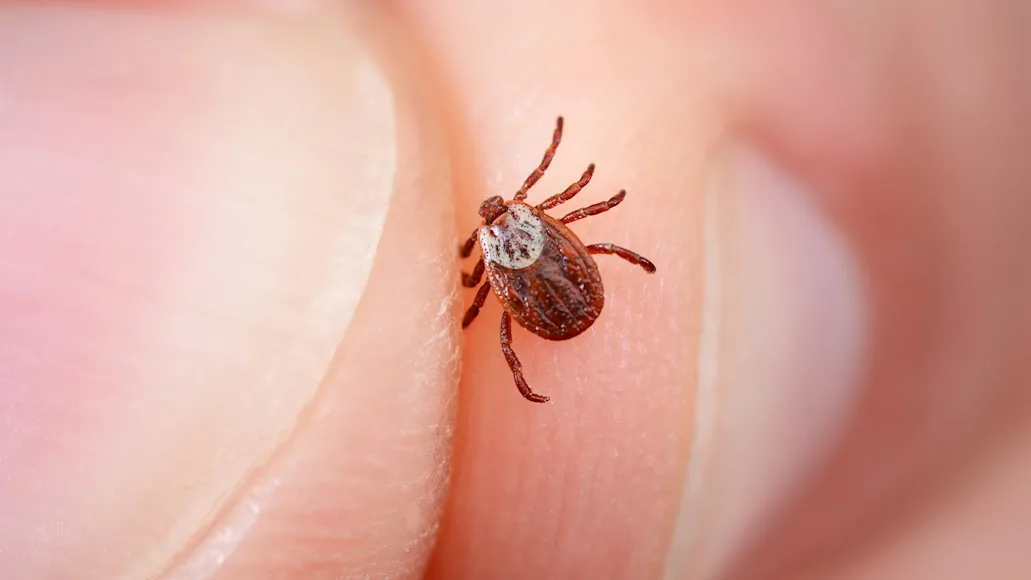Need to know how to remove a tick right now? No problem. I’ve got you. Having spent a lifetime outdoors and the last 25 years at an Upstate New York home whose yard is absolutely crawling with the horrible pariahs, I have removed more ticks from myself and others than I want to think too much about. It’s been a disgusting education, but with all that practice, I’ve gotten very good at it. So, I can tell you not only how to remove a tick the right way, but also how to avoid the wrong ways and what to do after you’ve pulled that nasty little bugger out of your flesh.
How to Remove a Tick: The Short Answer
If the head of a tiny, bloodsucking beast is writhing under your skin right at this moment and you can’t bear to have it in there one second longer, then here’s the short answer: Use a pair of fine-tipped tweezers to grasp the tick as close to its head as possible and pull straight upward with even, steady pressure until it pops out. Or, run to the drug store, grab a tick-removal tool, and do pretty much the same. Use this video from the University of Rhode Islands TickEncounter Resource Center as a guide.
How to Remove a Tick: Table of Contents
How a Tick Becomes Embedded
How to Remove a Tick with Tweezers
How to Remove a Tick with a Specialized Tool
How Not to Remove a Tick
What to Do After Removing a Tick
Frequently Asked Questions
How a Tick Becomes Embedded

Ticks don’t merely insert their horrifying mouthparts into you; they dig their way in via flesh-ripping hooks and then anchor themselves with a proboscis that’s studded with barbs—the little jerks. This is why they can be a little difficult to pull out.
But before they can dig in, they need to get themselves on your person first, which they do by climbing to the top of a blade of grass, forb, or twig and then reaching their disgusting little forelegs out in a posture called “questing.” There, they wait for you or some other unfortunate to walk past and brush the blade or twig so they can grab onto a shoe or pantleg. From there, if left unnoticed, they will make their way to your skin, find a soft spot, and start digging.
How to Remove a Tick with Tweezers
Even after removing scores of ticks, I still have a visceral reaction to seeing one embedded. The little a-holes are so nasty and repulsive that it is perfectly reasonable if your first reaction is to want to run or cry, rather than remove it. So, the first thing you might have to do to remove a tick is just swallow hard and decide you are going to be clinical about this. There’s plenty of time to be disgusted later. After that, follow these steps:

Disinfect the bit area with rubbing alcohol, or if that’s not handy, soap and water.
With a pair of fine-tipped tweezers, grasp the little bugger as close to your skin and as close to the tick’s head as possible.
Pull straight up with even pressure. Don’t twist or yank or pull to the side, any of which can tear the tick’s revolting body from its nasty head, leaving the latter still embedded in your flesh, which you don’t want. It may take a couple tries, and you may have to pull fairly hard, but eventually the tick should pop out. And “pop” is the right word, as it will usually pull free suddenly, often with a surprising little snap or pop.
Clean the area again with rubbing alcohol or soap and water.
How to Remove a Tick with a Specialized Tool
Personally, I stopped using tweezers years ago because, in my opinion, a number of widely available specialized tick-removal tools work better. These are very simple, most featuring nothing more than a small handle of some sort and a slot that gets progressively narrower between two pieces of plastic. You slide the tool over the tick until it’s trapped in the narrowing slot and then do as above: pull upward with steady pressure until the tick tip pops free, as illustrated below.

How Not to Do It
There are a handful of sources that still recommend crazy things like heating a needle until it’s red hot and sliding it under the tick until it backs out. Well, don’t do that. And don’t cover it with petroleum jelly and wait for it to want to leave for lack of air, either. Just do the above because it’s the quickest and safest way.
What to Do After Removing a Tick
Once you’ve got the awful thing out, wash your hands and the area around the bite with rubbing alcohol or soap and water. If you can’t get the head out, you can try removing it with the tweezers, but don’t worry too much if you can’t; it will heal over and work out naturally.
Meanwhile, if the removal went smoothly, you likely have a live tick crawling on your countertop. So, what to do with it? Well, you may want to have the horrible bug tested for bacteria, viruses, or parasites that cause tick-borne illnesses, and some states and private labs will do that for you. If so, put it in a jar or small sealable bag and call your state health department. Also, talk to your doctor; if they are open to prescribing a prophylactic single dose of antibiotic based on a tick-test result, it may be worth it. Otherwise, it won’t really tell you much. In fact, the CDC discourages this route for a few reasons: First, just because a tick is carrying a bad virus or bacteria doesn’t mean it passed on to you; second, there are false positives that can unnecessarily freak you out; and, third, you won't know if you’ve been infected until you start showing symptoms anyway.
Plus, you won’t get the satisfaction of killing the damn thing. It’s tempting to want to hit it with a hammer or squash it under a fingernail, but then you’ll have tick juice on your counter and possibly your hand, which isn’t good. Instead, watch it suffocate in a pool of rubbing alcohol, or flush it down the toilet, or fold it inside a piece of tape so it can’t possibly escape and throw it in the trash.
You’re welcome to call your doctor and tell them that you just removed a tick, but they will likely tell you to do the same thing you would if you didn’t call: Keep a close eye out for any symptoms, such as a bullseye rash, stiff joints, or flu-like symptoms. If you have any of these problems or just feel off after a tick bite, go to your doctor and tell them you recently removed a tick. The good news is that if you find and remove the tick within 24 hours of it becoming embedded, the odds are very good that you won’t have a problem. But if you have any symptoms, go to your doctor and get tested anyway to be safe.
Frequently Asked Questions
Q: Will a stuck tick head eventually come out?
Yes. If the head of an embedded tick pulls away from its body and remains embedded, try using a sterilized tweezer to grasp the head and pull it straight out. But if you can’t get it, don’t worry. It will heal over and work itself out eventually.
Q: Can I use alcohol to remove a tick?
That’s a bad idea. So-called topical “treatments” like applying alcohol or peroxide of petroleum jelly will just prolong the time a tick is embedded, and some can irritate the tick enough that it will regurgitate it's stomach content into you, increasing the odds of transmitting a nasty disease.
Q: Do all ticks carry Lyme disease?
No. Lyme disease is transmitted only by infected deer ticks or black-legged ticks. And not all ticks that can carry diseases do. Even for Lyme disease, the most common tick-borne illness in the U.S., scientists estimate that only 1 to 3 percent of bites end up transmitting the disease, even in areas where Lyme is common.


